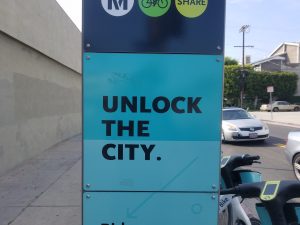
I once rented a Metro Bike Share bike in downtown Los Angeles and rode it across the city to Venice Beach. Awesome, right? “This is awesome!”, I thought. When I got to Venice, I found out it was NOT awesome. It was expensive and a major hassle. The downtown LA bikes are not allowed to be locked up at the kiosks in Venice, so I had to huff it all the way back downtown – ruining my day and costing me double the trip time, plus I wasn’t able to do anything in Venice because I couldn’t leave the bike unattended anywhere.
Why are private bike share bikes littering the sidewalks, available at the touch of few cell phone menu options, when Metro Bike Share bikes are a supreme pain in the a%% to rent and park?
I will tell you why: Metro Bike Share bikes are not subject to market forces. Metro Bike Share is a subsidy dumpster – a place where good intentions and public money go to die.
The term “subsidy dumpster” was first introduced to me in an essay by John Michael Greer entitled “The Crocodiles of Reality” published in 2014 on his now-defunct site The Archdruid Report.
To paraphrase Greer: a subsidy dumpster is a technology that looks like a viable option so long as nobody pays attention to the economic realities.*
How much money does Metro Bike cost the public? Does the service make money? How many people use it?
According to Metro Board Report, File # 2018-0479, from the Planning and Programming Subcommittee meeting on September 19, 2018, the Metro Bike Share program cost the public, from 2015 to 2018, $22 million.
The revenue generated by Metro Bike Share during that same period? $1.4 million.
Metro’s report notes that “grants”, and “cost reimbursement from partner cities”, offset Metro’s expenses – but that is a cost to the public of $22.2 million for an income of $1.4 million. That is a net cost to the public of $20.8 million from 2015 to 2018.
Up to that point, from 2015 to 2018, Metro Bike Share had provided 520,000 trips.
Each Metro Bike Share trip, then, cost the public an average of $40 while the users paid $2.69 on average.
How many people use private bike and scooter share services in Los Angeles, like Uber, Jump, and others? Really, who cares? They do so at no direct cost to the City nor County of Los Angeles nor do they invoke direct costs to Los Angeles County Metro.
Metro Bike Share ruined my day back in 2020, so this is me returning the favor by exposing it as the subsidy dumpster it truly is.
If you would like to find out more about Metro Bike Share, or any other Metro-related topic, visit Metro’s Legistar database to search through board reports without all the obnoxious pop-up windows and jive web-designer crap getting the way.
https://metro.legistar.com/Legislation.aspx
—
*
Greer explains: “Once the subsidy dumpster gets its funding, it goes through however many twists and turns its promoters can manage before economic realities take their inevitable toll. If the dumpster in question has to compete in the marketplace […] the normal result is a series of messy bankruptcies as soon as the government money runs short. If it can be shielded from the market, preferably by always being almost ready for commercial deployment but never actually quite getting there […] the dumpster can keep on being filled with subsidies for as long as the prospect of an imminent breakthrough can be dangled in front of politicians and the public. Since most people these days consistently mistake technical feasibility for economic viability, there’s no shortage of easy marks for this sort of sales pitch.”